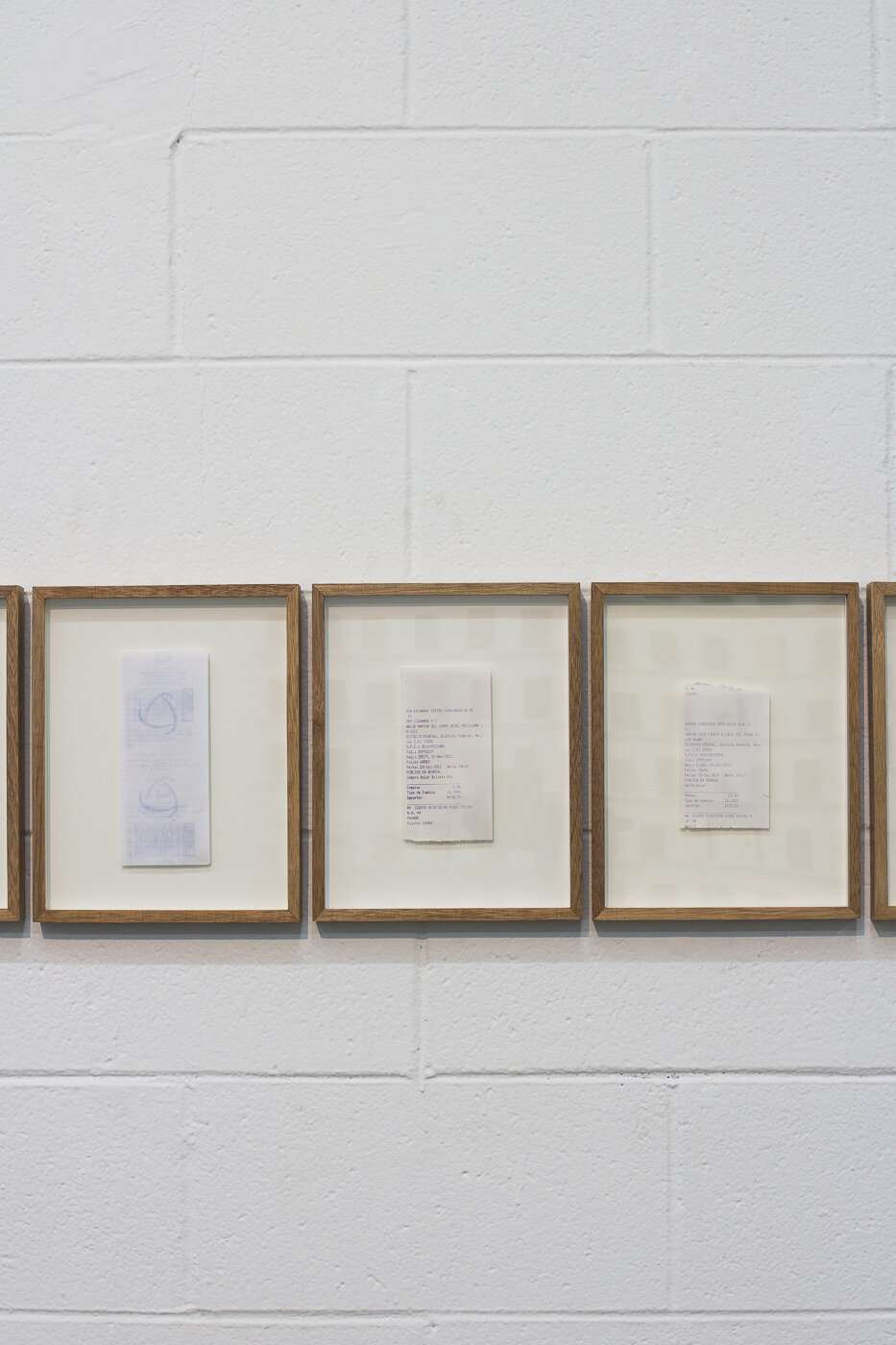Analog Currency
Group Exhibition | July 8-Aug. 26, 2017
This is a past exhibition.
This exhibition brings together a group of artists for whom the globalist promises of the Digital Age have fallen radically short. Their work calls attention to technologies and information structures that reinforce and expand colonial logics across political, economic, and cultural spheres.
About the Exhibition.
The creation of the World Wide Web in 1989—which marked a critical moment in the history of the Digital Revolution—expedited the proliferation of technologies that transformed the way information is gathered, stored, managed and distributed. These innovations that allowed for instantaneous global communication and access to seemingly boundless data also facilitated the capitalization of information itself—making it the currency of a new knowledge-economy that would eventually come to re-structure the economic, geopolitical, and social dimensions of our world.
This Information Age would be shaped in public discourse through narratives of immediacy, efficiency, and transparency—giving way to mythologies about the democratizing benefits these advancements could provide to historically marginalized and disenfranchised peoples. Unmediated access to limitless information and networks of communication seemed to promise expanded visibility and the potential to organize rapidly at an unprecedented scale. While the Zapatista uprisings in Mexico during the mid-1990’s and the more recent Arab Spring demonstrations have shown this to be possible, what has been less considered in this early history of information systems is what the long-term implications of the initial shift from analog to digital would be for these communities.
As fiber-optic cables were laid across deep ocean floors and server farms were established in remote and often undisclosed locations, the physical armature of our information infrastructure gradually disappeared from public view. What emerged was a shadowy architecture of collection, storage, and dissemination facilities wherein the technologies that emerged in the Digital Age evolved away from public scrutiny and oversight. This cleared the way for development of technologies that were put to the service of unregulated capitalist markets, weaponized for surveillance and policing, and more recently, mobilized to manipulate public opinion and in turn, entire political systems.
Analog Currency is set against the backdrop of dystopian realities that these technological changes of the Information Age have created in recent years. Conceived as an active platform in which multiple publics can engage critically with the present, Analog Currency is organized in two parts. The first is a group exhibition that brings together the work of a host of international artists including Sophia Al Maria, John Houck, Michael Mandiberg, Miguel Monroy, Pratchaya Phinthong, Tabita Rezaire, Jimena Sarno, Daniel Schwarz, and Martine Syms. The works included in the exhibition explore the re-materialization of the digital in conceptual and formal ways while interrogating the many structures that sustain it.
The ideas put forth by these works will be expanded by the second component of the project—a robust public program that will unfold throughout the summer. Embracing the productive slippage of the analog, this nexus of moments will explore the physical dissemination of knowledge through tangible, embodied exchanges. Programming highlights include screenings of Ana Mendieta's experimental and performative film works; curated conversations by UCLA’s voidLab about the subversive potential of crypto-currencies; artist-led workshops; discussions around Gulf Futurism; and readings concerning the hyper-visible production of black pain.
About the Artists.
Sophia Al Maria (b. 1983, Qatar) is an artist, writer and filmmaker. She studied comparative literature at the American University in Cairo and aural and visual cultures at Goldsmiths University of London. For the past few years she has been carrying out research around the concept of Gulf Futurism. Her work has been exhibited in various institutional shows around the world, including Black Friday, Whitney Museum of American Art, New York, NY, USA (2016); 2015 Triennial: Surround Audience, New Museum, New York, NY, USA (2015); Extinctions Marathon: Visions of the Future, Serpentine Gallery, London, UK (2014); and the 9th Gwangju Biennale, South Korea (2012).
John Houck (b. 1977, US) has shown extensively in the United States and abroad. He has had recent solo exhibitions at On Stellar Rays, New York (2016), and Johan Berggren Gallery in Malmö, Sweden (2015). He has also participated in group shows at the International Center of Photography, New York (2016); the Museum of Modern Art, New York (2015); and the Los Angeles County Museum of Art (2014). His works are in the collections of the Guggenheim Museum, New York, and the Los Angeles County Museum of Art. He has an MFA in Fine Arts from UCLA and a BA in Architecture from Colorado University. He also completed the Whitney Independent Study and Skowhegan School of Painting and Sculpture programs. He lives and works in Los Angeles.
Michael Mandiberg (b. 1977, US) is an interdisciplinary artist whose work ranges from large-scale installations and software-driven durational performances to socially-engaged pedagogy. They explore the poetics and politics of the information age, making visible processes that are often hidden in plain sight. Mandiberg's projects have been exhibited at the Los Angeles County Museum of Art (LACMA), The New Museum, Musée d’Art Moderne de la Ville de Paris, and the Arizona State University Museum and Library. They are the recipient of a LACMA Art+Technology Lab grant, three Eyebeam fellowships, and a Mellon fellowship at the CUNY Graduate Center. Mandiberg is Professor of Media Culture at the College of Staten Island/CUNY and Doctoral Faculty at the CUNY Graduate Center.
Miguel Monroy (b. 1975, Mexico) tries to disassemble the meaning of objects and systems in daily life through video, photography and sculpture. He earned BA in visual arts from UNAM and is certified in photography and new media through Centro de la Imágen (2001). His work has been shown in galleries and cultural spaces in Switzerland, Brazil, Spain, the United States, and Belgium. His most recent solo shows include Puesta en abismo, CoLab Projects, Austin, Texas (2014); Box de Sombra, La Chambre Blanche, Quebec, Canada (2012); Canon, Museo Experimental El Eco, Mexico City (2012); and Deuce, Alterna y Corriente, Mexico City (2010).
Pratchaya Phinthong (b. 1974, Thailand) lives and works in Bangkok. His works works often arise from the confrontation between different social, economic, or geographical systems. Solo exhibitions include Who will guard the gaurds themselves?, gb agency, Paris (2015); Broken Hill, Chisenhale Gallery, London (2013); Give More Than You Take, GAMeC (Galeria d’Arte Moderna e Contemporanea), Bergamo (2011) and CAC Brétigny (2010). Group exhibitions include Materials, Money and Crisis, MUMOK, Vienna; I Know You, Irish Museum of Modern Art, Dublin (both 2013); dOCUMENTA (13), Kassel; The Ungovernables, New Museum Triennial, New York; Modern Monsters / Death and Life of Fiction, Taipei Biennial (all 2012); Until it Makes Sense, Kadist Art Foundation, Paris and How to Work (More for) Less, Kunsthalle Basel (both 2011).
Tabita Rezaire (b. 1989, France) is a French born Guyanese / Danish new media artist whose work explores de-colonial health and knowledge through the politics of technology. By navigating architectures of power online and offline, her work tackles the pervasive matrix of coloniality and its effects on identity, technology, sexuality and spirituality. In 2016, Rezaire’s work was featured in exhibitions at the 9th Berlin Biennale; The Broad, Los Angeles; The Museum of Modern Art, Paris; and the Museum of Contemporary African Diasporan Arts (MoCADA), New York. She lives and works in Johannesburg, South Africa.
Jimena Sarno (b. Argentina) is a multidisciplinary artist and organizer. She works across a range of media including installation, sound, video, text and sculpture. Currently living in Los Angeles, her experience as a South American immigrant informs her practice. She is the organizer of analog dissident, a monthly discussion gathering that features two invited artists and encourages intersectional approaches and critical engagement outside of traditional art institutions. Her work has been exhibited at LACE, PØST, Human Resources, UCI Contemporary Art Center, Control Room, Fellows of Contemporary Art and Grand Central Art Center among others. She is the recipient of the 2015 California Community Foundation Fellowship for Visual Artists.
Daniel Schwarz’s (b. 1987, Germany) works examine sociopolitical crises through the lens of digital media. His practice critically engages with aspects of control and power structures, state authority, and cartography under the connective tissue of surveillance and loss of privacy. He exhibited and performed at the National Gallery of Canada; the 9th Berlin Biennale; the Nevada Museum of Art; the Massachusetts Museum of Contemporary Art (MassMoCA); the Baryshnikov Arts Center, New York; the Goethe Institute, Washington DC; Sónar Festival, Barcelona; the 70th Venice Film Festival; FILE – Electronic Language International Festival, Sao Paolo; roBOt Festival; and km temporaer amongst many others.
Martine Syms (b. 1988, US) uses video and performance to examine representations of Blackness and its relationship to American situation comedy, Black vernacular, feminist movements and radical traditions. Her artwork has been exhibited and screened extensively, including presentations at the New Museum, The Studio Museum in Harlem, Museum of Contemporary Art Los Angeles, MCA Chicago, Green Gallery, Gene Siskel Film Centre, and White Flag Projects. From 2007-2011 she was the co-director of the Chicago artist run project space Golden Age, and she currently runs Dominica Publishing—an imprint dedicated to exploring blackness in visual culture. She is the author of Implications and Distinctions: Format, Content and Context in Contemporary Race Film (2011).
Press
Sept. 7, 2017 | Analog Currency | The Brooklyn Rail
Credits
Analog Currency is organized by TMR and curated by Hanna Girma, TMR Assistant Curator.
TMR's program is made possible with the support of its Board of Directors, Big Mistake Patron Group, International Council, and Contemporary Council.
Support for this exhibition is provided by UCLA's voidLab.
Photo Credit: Stephen Aldahl. Copyright 2017. The Mistake Room Inc.









